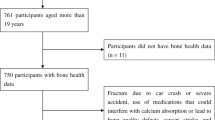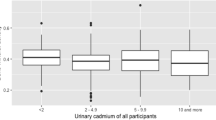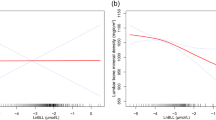Abstract
Low hemoglobin (Hb) level or anemia is associated with osteoporosis and bone fracture. Cadmium (Cd) and lead (Pb) exposure are also risk factors of osteoporosis and anemia. However, the role of anemia in Cd/Pb related bone loss remains unclear. The aim of present study was to investigate the association between Hb level and bone loss in a population with environmental lead and cadmium exposure. One hundred and ninety-four women and 108 men with different levels of Cd/Pb exposure were included in our study. The Cd/Pb exposure was determined using graphite-furnace atomic absorption spectrometry. Forearm bone mineral density (BMD) was determined by peripheral dual-energy X-ray absortiometry. Hb concentration was determined using an automatic blood cellcounter. A logistic model was established to predict the risk of osteoporosis. The BMDs of women that had the highest quartile BCd and BPb were markedly lower than that with the lowest quartile (p < 0.05). The BMD and the prevalence of osteoporosis in men with anemia were lower and higher than that with normal Hb (p < 0.05), respectively. In men, age, BPb and anemia were independent risk factors for osteoporosis. The odds ratio (OR) of men with anemia was 11.28 (95%confidence interval (CI):1.94-65.54) and 19.56 (95%CI: 2.98-128.78) compared to those with normal Hb after adjusting for potential cofounders. No such association was found in women. The area under the curve was 0.88 (95%CI: 0.82-0.96) in predicting osteoporosis using the logistic model in men. Linear discriminant analysis also showed that 90.7% of osteoporosis was correctly classified. Our data show that anemia is associated with incident of osteoporosis in men but not in women that environmentally exposed to Pb and Cd.




Similar content being viewed by others
Data availability
Data or materials used in the study are available from the corresponding author by request.
References
Akesson, A., Bjellerup, P., Lundh, T., Lidfeldt, J., Nerbrand, C., Samsioe, G., et al. (2006). Cadmium-induced effects on bone in a population-based study of women. Environmental Health Perspectives, 114, 830–834.
Åkesson, A., Barregard, L., Bergdahl, I. A., Nordberg, G. F., Nordberg, M., & Skerfving, S. (2011). Non-renal effects and the risk assessment of environmental cadmium exposure. Environmental Health Perspectives, 122, 431–438.
Al-Ghafari, A., Elmorsy, E., Fikry, E., Alrowaili, M., & Carter, W. G. (2019). The heavy metals lead and cadmium are cytotoxic to human bone osteoblastsvia induction of redox stress. PLoS One, 14, e0225341.
Arnett, T. R., Gibbons, D. C., Utting, J. C., Orriss, I. R., Hoebertz, A., Rosendaal, M., et al. (2003). Hypoxia is a major stimulator of osteoclast formation and bone resorption. Journal of Cellular Physiology, 196, 2–8.
Bhattacharyya, M. H. (2009). Cadmium osteotoxicity in experimental animals: Mechanisms and relationship to human exposures. Toxicology and Applied Pharmacology, 238, 258–265.
Bi, X., Feng, X., Yang, Y., Qiu, G., Li, G., Li, F., et al. (2006). Environmental contamination of heavy metals from zinc smelting areas in Hezhang County, western Guizhou. China. Environment International, 32, 883–890.
Buha, A., Jugdaohsingh, R., Matovic, V., Bulat, Z., Antonijevic, B., Kerns, J. G., et al. (2019). Bone mineral health is sensitively related to environmental cadmium exposure-experimental and human data. Environmental Research, 176, 108539.
Campbell, J. R., & Auinger, P. (2007). The association between blood lead levels and osteoporosis among adults–results from the third national health and nutrition examination survey (NHANES III). Environmental Health Perspectives, 115, 1018–1022.
Cesari, M., Pahor, M., Lauretani, F., Penninx, B. W. H. J., Bartali, B., Russo, R., et al. (2005). Bone density and hemoglobin levels in older persons: Results from the InCHIANTI study. Osteoporosis International, 16, 691–699.
Chen, X., Zhu, G., Gu, S., Jin, T., & Shao, C. (2009). Effects of cadmium on osteoblasts and osteoclasts in vitro. Environmental Toxicology and Pharmacology, 28, 232–236.
Chen, X., Wang, G., Li, X., Gan, C., Zhu, G., Jin, T., et al. (2013). Environmental level of cadmium exposure stimulates osteoclast formation in male rats. Food and Chemical Toxicology, 60, 530–535.
Chen, X., Wang, K., Wang, Z., Gan, C., He, P., Liang, Y., et al. (2014). Effects of lead and cadmium co-exposure on bone mineral density in a Chinese population. Bone, 63, 76–80.
Chen, X., Zhou, H., Li, X., Wang, Z., Zhu, G., & Jin, T. (2015). Effects of lead and cadmium co-exposure on hemoglobin in a Chinese population. Environmental Toxicology and Pharmacology, 39, 758–763.
Chen, X., Zhu, G., Wang, Z., Zhou, H., He, P., Liu, Y., et al. (2019). The association between lead and cadmium co-exposure and renal dysfunction. Ecotoxicology and Environmental Safety, 173, 429–435.
Chwalba, A., Maksym, B., Dobrakowski, M., Kasperczyk, S., Pawlas, N., Birkner, E., et al. (2018). The effect of occupational chronic lead exposure on the complete blood count and the levels of selected hematopoietic cytokines. Toxicology and Applied Pharmacology, 355, 174–179.
Coonse, K. G., Coonts, A. J., Morrison, E. V., & Heggland, S. J. (2007). Cadmium induces apoptosis in the human osteoblast-like cell line Saos-2. Journal Toxicology Environmental Health. Part A, 70, 575–581.
Dobrakowski, M., Boroń, M., Czuba, Z. P., Birkner, E., Chwalba, A., Hudziec, E., et al. (2016). Bloodmorphology and the levels of selected cytokines related to hematopoiesis in occupational short-term exposure to lead. Toxicology and Applied Pharmacology, 305, 111–117.
Ettinger, M. P. (2003). Aging bone and osteoporosis-strategies for preventing fractures in the elderly. Archives of Internal Medicine, 163, 2237–2246.
Fujimoto, H., Fujimoto, K., Ueda, A., & Ohata, M. (1999). Hypoxemia is a risk factor for bone mass loss. Journal of Bone and Mineral Metabolism, 17(3), 211–216.
Guralnik, J. M., Eisenstaedt, R. S., Ferrucci, L., Klein, H. G., & Woodman, R. C. (2004). Prevalence of anemia in persons 65 years and older in the United States: Evidence for a high rate of unexplained anemia. Blood, 104, 2263–2268.
Hardy, R., & Cooper, M. S. (2009). Bone loss in inflammatory disorders. Journal of Endocrinology, 201, 309–320.
Horiguchi, H. (2007). Anemia Induced by Cadmium Intoxication. Nihon eiseigakuzasshi. Japanese journal of hygiene, 62, 888–904.
Jalili, C., Kazemi, M., Taheri, E., Mohammadi, H., Boozari, B., Hadi, A., et al. (2020). Exposure to heavy metals and the risk of osteopenia or osteoporosis: a systematic review and meta-analysis. Osteoporosis International. https://doi.org/10.1007/s00198-020-05429-6
Jørgensen, L., Skjelbakken, T., Løchen, M.-L., Ahmed, L., Bjørnerem, A., Joakimsen, R., et al. (2010). Anemia and the risk of non-vertebral fractures: The Tromsø Study. Osteoporosis International, 21, 1761–1768.
Knowles, H. J. (2015). Hypoxic regulation of osteoclast differentiation and bone resorption activity.Hypoxia (Auckland, N.Z.) ,3,73–82.
Lee, E. A., Shin, D. W., Yoo, J. H., Ko, H. Y., & Jeong, S. M. (2019). Anemia and risk of fractures in older Korean adults: A nationwide population-based study. Journal of Bone and Mineral Research: The Official Journal of the American Society for Bone and Mineral Research, 34, 1049–1057.
Li, C., Ni, Z. M., Ye, L. X., Chen, J. W., Wang, Q., & Zhou, Y. K. (2018). Dose-response relationship between blood lead levels and hematological parameters in children from central China. Environmental Research, 164, 501–506.
Lim, H. S., Lee, H. H., Kim, T. H., & Lee, B. R. (2016). Relationship between heavy metal exposure and bone mineral density in Korean adult. Journal of Bone Metabolism, 23, 223–231.
Medeiros, D. M., Stoecker, B., Plattner, A., Jennings, D., & Haub, M. (2004). Iron deficiency negatively affects vertebrae and femurs of rats independently of energy intake and body weight. Journal of Nutrition, 134, 3061–3067.
Mitra, P., Sharma, S., Purohit, P., & Sharma, P. (2017). Clinical and molecular aspects of lead toxicity: An update. Critical Reviews in Clinical Laboratory Sciences., 54, 506–528.
Nakhaee, S., Amirabadizadeh, A., Brent, J., & Mehrpour, O. (2019). Impact of chronic lead exposure on liver and kidney function and haematologic parameters. Basic & Clinical Pharmacology & Toxicology, 124, 621–628.
Oh, Y. H., Moon, J. H., & Cho, B. (2017). Association between hemoglobin level and bone mineral density in Korean adults. Journal of Bone Metabolism, 24, 161–173.
Puzas, J. E., Sickel, M. J., & Felter, M. E. (1992). Osteoblasts and chondrocytes are important target cells for the toxic effects of lead. Neurotoxicology, 13, 783–788.
Rutten, E. P. A., Franssen, F. M. E., Spruit, M. A., & Wouters, E. F. M. (2013). Anemia is associated with bone mineral density in chronic obstructive pulmonary disease. COPD, 10, 286–292.
Utting, J. C., Flanagan, A. M., Brandao-Burch, A., Orriss, I. R., & Arnett, T. R. (2010). Hypoxia stimulates osteoclast formation from human peripheral blood. Cell Biochemistry Function, 28, 374–380.
Valderrábano, R. J., Lee, J., Lui, L. Y., Hoffman, A. R., Cummings, S. R., Orwoll, E. S., & Wu, J. Y. (2017). Older men with anemia have increased fracture risk independent of bone mineral density. The Journal of Clinical Endocrinology and Metabolism, 102, 2199–2206.
Wallin, M., Barregard, L., Sallsten, G., Lundh, T., Lorentzon, M., Mellström, D., et al. (2016). Low-level cadmium exposure is associated with decreased bone mineral density and increased risk of incident fractures in elderly men: The MrOS Sweden study. Journal of Bone and Mineral Research: The Official Journal of the American Society for Bone and Mineral Research, 31, 732–741.
Watanabe, H., Payton, M., Korrick, S., & Rotnitzky, A. (1994). The relationship between bone lead and hemoglobin. JAMA, 272, 1512–1517.
World Health Organization. (1968). Nutritional anaemias. Report of a WHO Scientific Group. Technical Report Series No. 405. World Health Organization, Geneva
Zhang, S., Sun, L., Zhang, J., Liu, S., Han, J., & Liu, Y. (2020). Adverse Impact of Heavy Metals on Bone Cells and Bone Metabolism Dependently and Independently through Anemia. Advanced Science (weinh), 7, 2000383.
Zhao, C., Thomson, C. A., Mikel, A., Nicholas, J. S., David, V. W., Lewis, C. E., et al. (2010). The relationship between incidence of fractures and anemia in older multiethnic women. Journal of the American Geriatrics Society, 58, 2337–2344.
Zhao, G. Y., Zhao, L. P., He, Y. F., Li, G. F., Gao, C., Li, K., et al. (2012). A comparison of the biological activities of human osteoblast hFOB1.19 between iron excess and iron deficiency. Biological trace element research, 150, 487–495.
Acknowledgements
This study was funded by National Natural Science foundation of China (No. 81773460, 81102148) and Natural Science Foundation of Jiangsu Province (no. BK20161609).
Author information
Authors and Affiliations
Corresponding authors
Ethics declarations
Conflicts of interest
The authors declare that there are no conflicts of interest.
Consent to participate
Informed consent was obtained from each participate.
Consent for publication
Consent was obtained from each author.
Ethical approval
We obtained the approval from the Institutional Review Board of Fudan University. Declaration of Helsinki was followed during the study.
Additional information
Publisher's Note
Springer Nature remains neutral with regard to jurisdictional claims in published maps and institutional affiliations.
Rights and permissions
About this article
Cite this article
Wang, M., Wang, X., Cui, W. et al. The association between hemoglobin level and osteoporosis in a Chinese population with environmental lead and cadmium exposure. Environ Geochem Health 44, 1673–1682 (2022). https://doi.org/10.1007/s10653-021-01129-0
Received:
Accepted:
Published:
Issue Date:
DOI: https://doi.org/10.1007/s10653-021-01129-0




